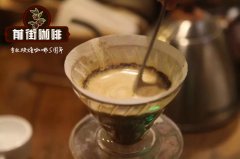Liberica Coffee beans introduce Liberica and Arabica, Robusta makes espresso

Professional coffee knowledge exchange more coffee bean information please follow the coffee workshop (Wechat official account cafe_style)
If beans are not used well, even if there are expensive machines and professional personnel, they will still work for free. Today's coffee drink will bring you to understand the soul of coffee-the three native species of coffee beans: Arabica, Robusta, and Liberica. The appearance is spoon-shaped.
Generally speaking, Arabica species still account for 75% of the world's total coffee production, Robusta accounts for about 20%, and Liberika trees account for only 1%, which is rare.
Arabica accounts for about 59% of the coffee beans in circulation in the global market. because of its high sour taste and aroma, Arabica is the most suitable for direct drinking of all coffee varieties, usually as long as a cup of coffee is mixed with 34% robusta beans. The whole cup of coffee will be robusta coffee flavor.
Some people think it's fragrance, but most people can't stand it, even think it's musty, and Robusta's bitterness is hard to understand.
Robusta coffee beans contain almost twice as much caffeine as Arabica. Robusta beans look more round than Arabica beans. Robusta species is also known as "industrial coffee", because only a few Robusta coffee beans, can brew a lot of coffee liquid, can effectively save costs. Robusta species are grown in large quantities in Vietnam, and most of these beans are sold to large canned coffee factories. At present, Robusta accounts for about 41% of the coffee beans in circulation worldwide. Librika is mainly found in West Africa, which is highly adaptable to the environment, but it is unable to resist leaf rust and has less flavor than Arabica, so it is only traded in West African countries, including Libya and Ivory Coast. it is difficult to find the Laiberian species in the international market.
Important Notice :
前街咖啡 FrontStreet Coffee has moved to new addredd:
FrontStreet Coffee Address: 315,Donghua East Road,GuangZhou
Tel:020 38364473
- Prev

What kind of coffee bean is Liberika? what kind of Liberica coffee is it? is it good?
Professional coffee knowledge exchange more coffee bean information please follow the coffee workshop (Wechat official account cafe_style)
- Next

Liberika planting regional characteristics description of Liberika flavor characteristics Liberika cooking parameters
Professional coffee knowledge exchange more coffee bean information please follow the coffee workshop (Wechat official account cafe_style)
Related
- Beginners will see the "Coffee pull flower" guide!
- What is the difference between ice blog purified milk and ordinary milk coffee?
- Why is the Philippines the largest producer of crops in Liberia?
- For coffee extraction, should the fine powder be retained?
- How does extracted espresso fill pressed powder? How much strength does it take to press the powder?
- How to make jasmine cold extract coffee? Is the jasmine + latte good?
- Will this little toy really make the coffee taste better? How does Lily Drip affect coffee extraction?
- Will the action of slapping the filter cup also affect coffee extraction?
- What's the difference between powder-to-water ratio and powder-to-liquid ratio?
- What is the Ethiopian local species? What does it have to do with Heirloom native species?

